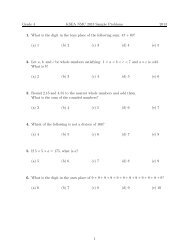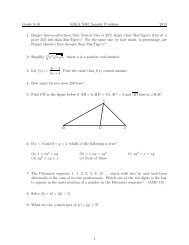Download KSEA Letters 40-3, Apr. 2012 [pdf] - Korean-American ...
Download KSEA Letters 40-3, Apr. 2012 [pdf] - Korean-American ...
Download KSEA Letters 40-3, Apr. 2012 [pdf] - Korean-American ...
Create successful ePaper yourself
Turn your PDF publications into a flip-book with our unique Google optimized e-Paper software.
TECHNICAL ARTICLES<br />
INTERCONNECTED NETWORK OF THE CELL CYCLE, CIRCADIAN RHYTHMS,<br />
AND DNA DAMAGE RESPONSE<br />
[Christian Hong]<br />
Assistant Professor, Molecular and Cellular Physiology<br />
University of Cincinnati College of Medicine<br />
Fundamental cellular processes that maintain most organisms’ health and survival include cell cycle, DNA damage response, and<br />
circadian rhythms. Cell cycle is equipped with multiple checkpoints for controlled growth, DNA replication, and divisions. DNA<br />
damage response (DDR) mechanisms control cell fate by either repairing single or double strand breaks, or triggering apoptosis for<br />
programmed cell death when the damage is fatal. Last, but not least, is circadian rhythm that keeps track of time of a day, and plays a<br />
central role in most organisms for setting the sleep/wake cycle, feeding rhythms, and other daily activities. These distinct molecular<br />
mechanisms communicate with each other and create a complex bio-molecular network to optimize conditions for cells to grow and<br />
adapt to the surrounding environment. Perturbations and dysfunctional cellular responses in this network may lead to diseases such<br />
as cancer, obesity, and sleep disorders among many others.<br />
Figure 1. Simple schematic of<br />
time-delayed negative feedback<br />
loop of Neurospora circadian<br />
rhythms<br />
The mechanistic blueprints of circadian rhythms are similar from Neurospora crassa to Mus musculus<br />
[1]. In Neurospora, the heterodimeric transcription factor, WCC that contains a conserved PAS<br />
domain, activates a core clock component designated frq. The FRQ protein translocates into the<br />
nucleus and inhibits its own transcription factor, WCC. In brief, this creates a time-delayed negative<br />
feedback loop, which is at the heart of circadian rhythms [1] (Figure 1). While this circuit may be<br />
at the core of the circadian clock system, its operation, however, is much more complex involving<br />
interlocked feedback loops, transcriptional, post-transcriptional, and post-translational regulations<br />
[2].<br />
Cell cycle and circadian rhythms are coupled despite their discrete functions. The circadian gated<br />
cell division cycles are observed in various organisms from cyanobacteria to mammals [3-6]. A<br />
mammalian circadian transcription factor, BMAL1/CLOCK, directly binds the E-box in the Wee1<br />
promoter and activates its transcription. WEE1 is one of the key cell cycle kinase that phosphorylates and inactivates the Mitosis<br />
Promoting Factor (MPF) that facilitates the entry into the mitosis. The abundance and activity of WEE1 have been shown to oscillate<br />
and be transiently elevated during the evening in mouse liver [5]. These, in turn, determine the duration of G2-phase. Cells divide<br />
in late evening when the WEE1 level decreases in order to allow cells to enter into the M-phase. The component of the cell cycle<br />
that is controlled by WEE1 operates in concert with another regulatory system that is<br />
periodically imposed on WEE1 by the circadian clock.<br />
The above seemingly unidirectional communication was recently shown to be conditionally<br />
bidirectional. DNA damage induces responses that arrest the cell cycle, or<br />
lead to programmed cell death, e.g. apoptosis. Ionizing radiation causes DNA doublestrand<br />
breaks that trigger signaling cascades via ATM and CHK2 [7]. In Neurospora<br />
crassa (filamentous fungi) and in mammals, the CHK2 checkpoint kinase physically<br />
interacts with a core clock components, FRQ and PER1 [8, 9], respectively, and represents<br />
an intersection point between cell cycle regulation and the circadian clock.<br />
The CHK2 kinase phosphorylates and promotes premature degradations of FRQ/<br />
PER1, which creates phase shifts in the circadian clock (Figure 2). The implications of<br />
such a phenotype raise the hypothesis that the cell cycle machinery utilizes circadian<br />
rhythms to activate WEE1/SWE1 by prematurely degrading FRQ [10]. This degradation<br />
removes the negative feedback on its transcription factor, WCC, which will then<br />
activate Swe1 and arrest cell cycle progression and provide time for DNA repair. There<br />
are additional candidates that participate in the molecular coupling of the cell cycle<br />
and the circadian clock. The transcript of c-Myc oscillates with a circadian period,<br />
and its transcription is suppressed by a heterodimeric circadian transcription factor,<br />
BMAL1/NAPS2 [11]. The molecular details of this coupling, however, remain unex-<br />
Figure 2. DNA damage activates Chk2, which<br />
phosphorylates one of the core circadian clock<br />
component, PER1 in mammals and FRQ in<br />
Neurospora, resulting in phase shifts of circadian<br />
rhythms<br />
14<br />
<strong>KSEA</strong> LETTERS Vol. <strong>40</strong> No. 3 <strong>Apr</strong>il <strong>2012</strong>


![Download KSEA Letters 40-3, Apr. 2012 [pdf] - Korean-American ...](https://img.yumpu.com/23972233/16/500x640/download-ksea-letters-40-3-apr-2012-pdf-korean-american-.jpg)
![Download KSEA Letters 40-2, Jan. 2012 [pdf] - Korean-American ...](https://img.yumpu.com/23972281/1/190x245/download-ksea-letters-40-2-jan-2012-pdf-korean-american-.jpg?quality=85)
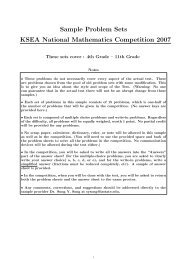


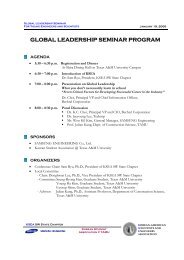




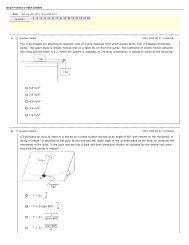
![Download KSEA Letters 40-4, Jun. 2012 [pdf] - Korean-American ...](https://img.yumpu.com/23972210/1/190x245/download-ksea-letters-40-4-jun-2012-pdf-korean-american-.jpg?quality=85)

